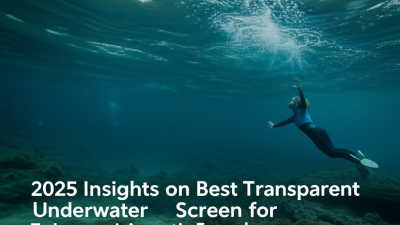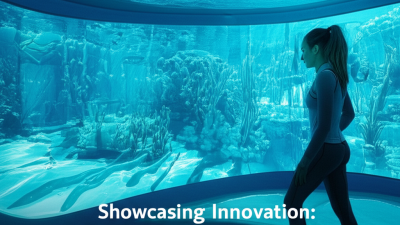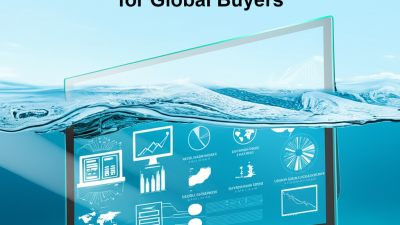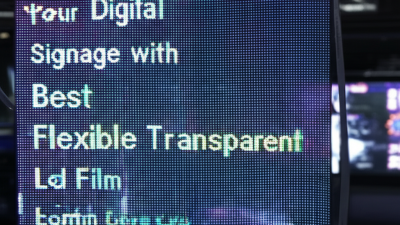
-
Home
-
Products
-
About Us
-
Case
-
News
-
BLOG
-
FAQ
-
Contact Us
Leave Your Message

The use of a Transparent Underwater Screen in interactive exhibits is revolutionizing the way audiences engage with content. According to a recent report by the International Association of Amusement Parks and Attractions (IAAPA), immersive technologies have seen a staggering growth rate of 25% annually, with interactive installations becoming increasingly popular among museum and aquarium settings. Transparent displays not only enhance visual appeal but also create a captivating experience that combines education and entertainment. Reports suggest that up to 70% of visitors are more likely to remember information presented through engaging digital formats. As institutions strive to create unforgettable experiences, understanding how to effectively implement a Transparent Underwater Screen can bridge the gap between technology and storytelling, captivating diverse audiences while promoting deeper connections with aquatic life.
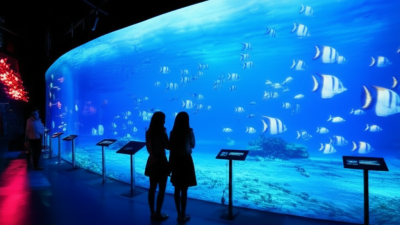
The innovative technologies behind transparent underwater screens have revolutionized how interactive exhibits engage audiences. These advanced displays leverage OLED (Organic Light Emitting Diode) technology, allowing for vibrant visuals that create captivating experiences while remaining fully transparent when not in use. By utilizing a combination of sensors and modern projection techniques, exhibits can seamlessly blend digital content with real-world elements in environments like aquariums, museums, and educational centers.
Additionally, the integration of augmented reality (AR) enhances the functionality of these screens, enabling visitors to interact with the displayed images in real-time. This interactivity elevates the learning experience, as users can explore marine life or historical artifacts in a way that is both immersive and educational. The use of transparent screens not only raises the aesthetic appeal of an exhibit but also transforms passive viewing into an engaging, participatory activity, making it a powerful tool for educators and curators alike.
| Exhibit Type | Audience Engagement Level | Average Interaction Time (minutes) | Technical Requirements | Cost Estimate ($) |
|---|---|---|---|---|
| Marine Life Display | High | 15 | HD Projector, Interactive Software | 5,000 |
| Underwater Art Installations | Medium | 10 | LED Panels, Touch Responsive Screen | 3,500 |
| Educational Displays | Very High | 20 | Interactive Learning Software, Sensors | 7,500 |
| Aquatic Games | High | 12 | Gesture Recognition System, Water-Resistant Hardware | 6,000 |
Transparent underwater screens are revolutionizing the way interactive exhibits engage visitors. One of the key benefits of these screens is their ability to create an immersive experience that captivates audiences. Artists and curators can blend digital content with the physical elements of the exhibit, allowing for a seamless interaction between the viewer and the displayed information. This combination not only enhances the visual appeal but also stimulates curiosity, encouraging visitors to explore and interact more deeply.
Another significant advantage of transparent underwater screens is their versatility in various environments. Whether in aquariums, museums, or educational facilities, these screens provide a unique platform for storytelling that adapts to different themes. They allow for dynamic presentations that can change in real-time, responding to viewer engagement and environmental factors. This adaptability means exhibits can remain fresh and relevant, drawing repeat visitors and fostering a deeper connection with the subject matter. Ultimately, the integration of transparent underwater screens transforms passive observation into active participation, enhancing visitor engagement in meaningful ways.
In recent years, museums have increasingly turned to transparent underwater screens as a means to enhance interactive exhibits, providing visitors with an immersive experience that emphasizes the beauty and fragility of marine ecosystems. Successful case studies have demonstrated how these screens can effectively showcase living marine life, allowing visitors to engage with the environment in a new and captivating way.
According to a report by the International Council of Museums, integrating interactive technology in exhibits boosts visitor engagement by 47%, making underwater screens a valuable asset for modern museums.
One notable example is the use of transparent screens to display aquaristic environments that reflect clean and sustainable ocean conditions. By curating these aquarium-like displays, museums not only educate the public about marine biodiversity but also inspire a sense of responsibility regarding environmental preservation.
A study from the Marine Conservation Society revealed that 65% of museum visitors reported a greater awareness of marine conservation issues after interacting with such exhibits. This highlights the potential impact of combining transparent underwater screens with live marine displays in transforming visitor perceptions and fostering a commitment to ocean sustainability.
Creating engaging interactive content for transparent underwater displays requires thoughtful design. One essential tip is to leverage the transparency of the screen. Content should be layered effectively, with background images or videos that complement the primary interactive elements. By placing engaging visuals behind the interface, you can enhance the depth and context of the interactive experience. This not only captivates the audience but also encourages them to explore further.
Another critical aspect is user interaction. Design the interface to be intuitive, allowing users to navigate easily through the content. Incorporating touch-sensitive areas encourages exploration; consider using larger, well-defined hotspots for interaction to ensure a seamless user experience even in an engaging underwater environment. Additionally, storytelling elements can be woven into the interactive content, creating a narrative that guides users through their experience, making it not only informative but also memorable.
Lastly, testing and iteration are key to refining the design. Gather feedback from users during trials and adapt the content based on their experiences. This iterative process will help you create a more polished and engaging interactive exhibit that resonates with diverse audiences.
The use of transparent underwater screens in interactive exhibits has revolutionized the way museums and aquariums engage with their visitors. By leveraging digital technologies, these screens not only allow for captivating visual displays but also invite active participation from visitors, fostering a deeper connection with the exhibits. For instance, interactive aquarium setups encourage guests to touch the screens and explore a plethora of information about marine life, enhancing the learning experience while making the information easily accessible.
Measuring visitor interaction through analytics is crucial for optimizing the effectiveness of these exhibits. Implementing methodologies such as the Model for Museum Exhibit User Experience (MEUX) allows curators and designers to quantify visitor experiences and assess the impact of such interactive elements on overall visitor satisfaction. By analyzing data collected from user interactions, exhibition planners can continuously refine their displays, ensuring that they not only capture attention but also deliver educational value and engagement.
Embracing these insights, future exhibitions can be tailored to meet the evolving needs and preferences of visitors, ultimately enriching their overall experience.
